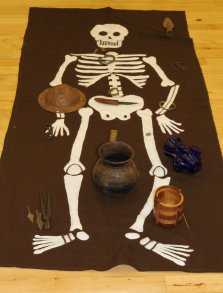At Gripping History, we feel it is essential to tailor the programme for your day to the needs of the children and to your requirements, depending on your areas of study. Scroll down the page here to find out about the workshop choices available and read some comments from teachers who have chossen these as part of their Gripping History day. If you have an idea for a workshop, which is not listed here, we can create one to suit.
Handling Objects
Suitable for all year groups
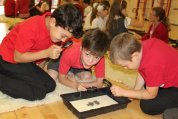 |
Main Activity: The children sit in a circle on the floor. Cathy places a replica historical object in a drawstring bag. The bag is then passed round the circle 5-6 times. Eache time a new child gets the bag, they feel inside and decide on an adjective to describe the object. They are encouraged to think about texture, weight, materials and structure, rather than guessing what the object is. The children usually respond with adjectives such as ‘cold’, ‘rough’, ‘pointy’, ‘bowl shaped’ or ‘made of metal’. Once a few children have described the object, all the other children are asked if they can guess what the object might be. We then reveal the object and decide what it was used for and who might have used it. Extension Activity: If you choose a longer version of this activity, the children break away from the circle and are given a small ‘finds’ tray, a magnifying glass, a recording sheet and a pencil. Each small group then has a new object to observe and draw. The learning about materials and the possible owner of the object is reinforced on the recording finds sheet. A teacher says... 'The children enjoyed the suspense of finding out what was inside the bag. It kept them engaged and interested. They loved using the magnifying glasses - made them feel like real historians.' |
Grave Goods
More suitable for Y4/5/6.
|
|
Main Activity: The learning objectives for this activity focus on understanding the means by which we gain evidence about the past. The children learn about which types of materials decompose underground and which do not. They also consider the main reasons that we find a record of the past underground and how objects got there. The centre point of the activity is the gradual ‘excavation’ of a trench, by means of the removal of layers of fabric. At the bottom of the trench, the children discover a friendly looking cloth skeleton, who has been buried with a range of objects. The children then begin to work out who the person might have been and their status etc. Extension Activity: If you choose a longer version of this activity, the children will be given a ‘finds’ tray with one of the buried objects. They will also be given a magnifying glass, recording sheet and pencil. They will draw the object, record the place the object was found in the grave and then attempt to draw a reconstruction of the burial on the day the person was buried. This will give them the opportunity to demonstrate their understanding of what decomposes and what doesn’t. They will be shown some visual examples to give them some ideas. A teacher says... 'This was a really effective but simple activity. It was a big hit.' Another teacher says...'This session certainly had the wow factor for the children who were hooked and delighted with the reveal of each layer of the grave. They loved having an opportunity to handle objects and share their ideas about who could possibly be in the grave.' |
Runes and Writing
Suitable for all year groups studying Vikings.
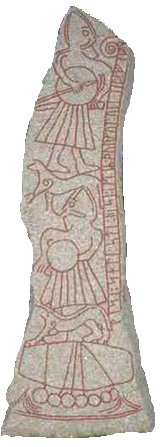 |
Main Activity: The children are given a sheet with the Vikings runes compared with our letter. We discuss these and point out features. We then look at some examples of rune stones and consider the purpose of these stones. The children then begin to familiarise themselves with the letters by transliterating a simple phrase. They then create their own message for their own rune stone and present their message. The children usually come up with phrases along the lines of ‘George was a fierce warrior and slew a horrible dragon.’ Or ‘Sophie thanks Odin for saving her sister from a sea monster.’ Often children can complete this activity afterwards and present it neatly if wished. A teacher says... 'The children enjoyed this activity. It was more than just writing in 'code'. The children loved making their own runestone inscription.' |
Exploring Shields
Suitable for all year groups
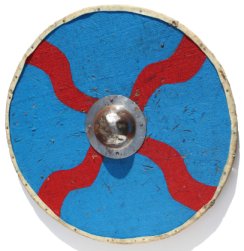 |
Main Activity: The purpose of this activityis to consider the materials and methods of construction of an early medieval shield and also to consider the cultural and social significance of ‘shield brothers’. The children are shown replicas of some elements of a shield: the boss, rivets, rawhide. They handle these and look at a complete replica shield to identify how the components are used in the finished item. The children then label the elements needed to make a shield on a recording sheet. The next stage of the activity is to draw a design for a shield. They are given some visual examples to inspire them. During the activity the children are offered the opportunity to hold the replica shield and feel its weight and bulk for themselves. A teacher says... 'Having the separate (replica) elements of the shield to show and feel was really good. It was also cross-curricular as we were able to talk about the choices of materials that had been used to construct the shield.' |
Exploring Food
Suitable for all year groups. (different version of the activity for younger and older children)
 |
Main Activity: The purpose of this activity is to draw attention to the differences between the modern and early mediaeval diets. Concepts covered include the places of origin of food stuffs, seasonality, available methods of preserving foods and awareness of modern processing of food. The younger children begin by ‘hunting’ for images of food items which have been hidden for them to find. As a group, we then use two hoops to sort the pictures into modern and early medieval foods, discussing the reasons for foods being unavailable in the past. The children are then asked to select ingredients for a feast using an image based recording sheet. The older children are asked to compare their own favourite foods to those they think people in the past might have eaten. They then try to find foods that they would like to eat in a source pack showing whether foods were available or not and whether they were everyday or occasional items. The children are then given a series of lunch time foods and they are asked to sort their lunch items. They place the modern foods on a plastic plate and the early medieval foods on a wooden plate. A teacher says... 'A really simple activity to make the children think about their own food and the differences in the past. Everyone was engaged and there were some involved discussions amongst the groups.' |
Exploring Textiles
Suitable for Y4/5/6
Main Activity: The children are presented with a range of items involved in fabric production: fleece, carding combs, drop spindle etc. A series of labels are distributed amongst the group and they discuss together where to place their label. Numbers are then given out and the children are asked to place their number to indicate the order of the fabric production process. The children are shown images and might even have the opportunity to try some drop spinning. They may handle the finished hand-woven fabric. The children also consider the difference between clothing today and in the past. They will all understand how long it took to make a garment and how this contrast with a the modern ‘throw away’ fashion culture.
Extension Activity: We then look at tablet weaving, which is used to decorate the hems and cuffs of the garments. A variety of examples are passed round and the children then design their own tablet woven band on paper, using symmetry and reflection.
A teacher says... 'I found this facinating and learnt such alot. I am looking forward to using your fabulous resources, especially the tablet weaving patterns, where we can bring in some cross-curricular maths too.'
Board Games
Suitable for Y3/4/5/6.
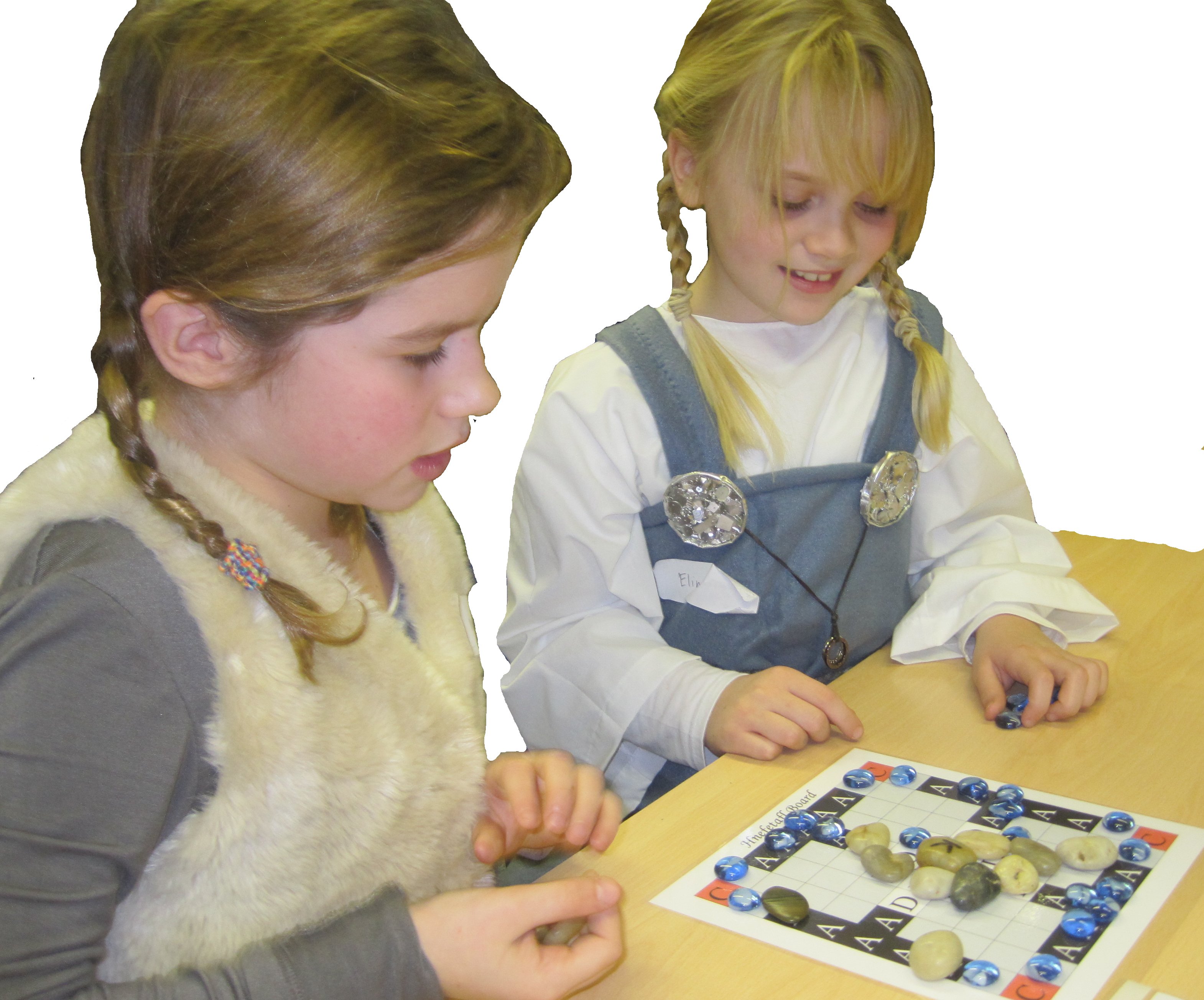 |
Main Activity: Children are asked to consider their leisure activities. Examples given usually include television, books and computers. They children then consider whether the Vikings/Saxons would have these past times. Depending on your topic of study, the children will then learn to play either ‘Nine Men’s Morris’ or ‘Hnefertafl’ Children will be provided with game boards and glass playing pieces. A teacher says... 'This activity was such a success, we've had requests for these game boards at wet playtime!' |
Settlement and Place Names
Suitable for Y3/4/5/6
 |
Main Activity: The children are asked to imagine they are a boat load of settlers, sailing up a river, looking for a place to build a new settlement. They are given various criteria for their new settlement location and discuss the priorities. They then select their village from a series of images of Saxon/Viking villages. They are then given a series of place name elements (either Saxon or Viking depending on your topic) and familiarise themselves with these. Finally they discuss and select a name for their village and write this on a wooden sign post. Extension Activity: The children carry out a challenge to work out the meaning of a variety of place names and create place names to reflect given characterisitcs. They then look at a local map and identify any Viking/Saxon placename elements in their own location. A teacher says... 'The pupils have loved inventing their own place/settlemnt names and have also enjoyed seeing the link with people's names and where they settled. The resulting work has been of a good quality.' Another teacher says... 'The children loved having an opportunity to create their own settlement names and picking their own home. ' |
Preparing for a Voyage
Suitable for all year groups.
Main and Extended Activity: In this roleplay activity, the children are challenged to trade for the items they will need in order to make a voyage across the sea to a new settlement. They will need to collect food, shelter, clothing etc to enable them to make their journey safely. The children work in groups and are allocated an 'occupation' e.g. furier, fisherman, blacksmith etc. Each group will have goods to trade and will be given some 'silver' coins to assist their trading. When the trading period is over, the children will assess what sort of boat they can build and whether they have enough supplies to make a successful voyage. There are 3 versions of this activity which can last 40 mins, 60 mins or 90mins.
A teacher says... 'All 3 classes really enjoyed this activity. It enabled the children to work in teams and to use negotiation skills. The way you explained the activity was great. You made it so adpatable and gave us loads of ideas about how to tweak it to suit our class. The game really enabled the children to see how much preparation was needed to make a voyage and to compare this with their own modern experience.'
Another teacher says... 'This was an action-packed session that was a favourite amongst the children. They loved rolling the dice at the end to find out if their family had survived the voyage! '






